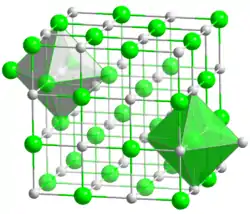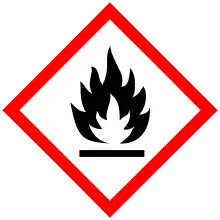Hafnium carbide
 | |
| Identifiers | |
|---|---|
3D model (JSmol) |
|
| ChemSpider | |
| ECHA InfoCard | 100.031.910 |
| EC Number |
|
PubChem CID |
|
CompTox Dashboard (EPA) |
|
| |
| |
| Properties | |
| HfC | |
| Molar mass | 190.50 g/mol |
| Appearance | black odorless powder |
| Density | 12.2 g/cm3[1] |
| Melting point | 3,900 °C (7,050 °F; 4,170 K)[2] |
| insoluble | |
| Structure | |
| Cubic crystal system, cF8 | |
| Fm3m, No. 225 | |
| Hazards | |
| GHS labelling: | |
 | |
| Warning | |
| H228 | |
| NFPA 704 (fire diamond) | |
Except where otherwise noted, data are given for materials in their standard state (at 25 °C [77 °F], 100 kPa).
Infobox references | |
Hafnium carbide (HfC) is a chemical compound of hafnium and carbon. With a melting point of about 3900 °C, it is one of the most refractory binary compounds known.[2] However, it has a low oxidation resistance, with the oxidation starting at temperatures as low as 430 °C.[3]
Hafnium carbide is usually carbon deficient and therefore its composition is often expressed as HfCx (x = 0.5 to 1.0). It has a cubic (rock-salt) crystal structure at any value of x.[4]
Hafnium carbide powder is obtained by the reduction of hafnium(IV) oxide with carbon at 1800 to 2000 °C. A long processing time is required to remove all oxygen. Alternatively, high-purity HfC coatings can be obtained by chemical vapor deposition from a gas mixture of methane, hydrogen, and vaporized hafnium(IV) chloride.
Because of the technical complexity and high cost of the synthesis, HfC has a very limited use, despite its favorable properties such as high hardness (>9 Mohs[5]) and melting point.[2]
The magnetic properties of HfCx change from paramagnetic for x ≤ 0.8 to diamagnetic at larger x. An inverse behavior (dia-paramagnetic transition with increasing x) is observed for TaCx, despite its having the same crystal structure as HfCx.[6]
See also
- Tantalum hafnium carbide, very refractory
References
- Physical Constants of Inorganic Compounds in Lide, D. R., ed. (2005). CRC Handbook of Chemistry and Physics (86th ed.). Boca Raton (FL): CRC Press. pp. 4–44 ff. ISBN 0-8493-0486-5.
- Harry Julius Emeléus (1968). "Metal Carbides". Advances in Inorganic Chemistry and Radiochemistry. Academic Press. pp. 169–170. ISBN 978-0-12-023611-4.
- Shimada, Shiro (October 1992). "Oxidation Kinetics of Hafnium Carbide in the Temperature Range of 480° to 600°C". Journal of the American Ceramic Society. 75 (10): 2671–2678. doi:10.1111/j.1151-2916.1992.tb05487.x.
- Lavrentyev, A.A.; Gabrelian, B.V.; Vorzhev, V.B.; Nikiforov, I.Ya.; Khyzhun, O.Yu.; Rehr, J.J. (26 August 2008). "Electronic structure of cubic HfxTa1–xCy carbides from X-ray spectroscopy studies and cluster self-consistent calculations". Journal of Alloys and Compounds. 462 (1–2): 4–10. doi:10.1016/j.jallcom.2007.08.018.
- James F. Shackelford; William Alexander, eds. (2001). CRC Materials Science and Engineering Handbook (3rd ed.). CRC Press. ISBN 978-0-849-32696-7.
- Aleksandr Ivanovich Gusev; Andreĭ Andreevich Rempel; Andreas J. Magerl (2001). Disorder and Order in Strongly Nonstoichiometric Compounds: Transition Metal Carbides, Nitrides, and Oxides. Springer. pp. 513–516. ISBN 978-3-540-41817-7.
